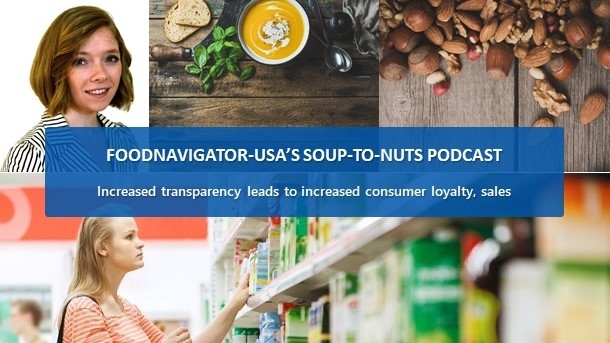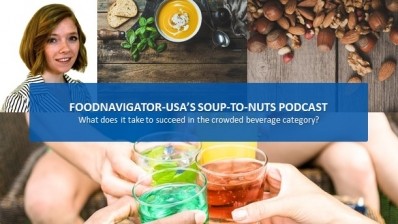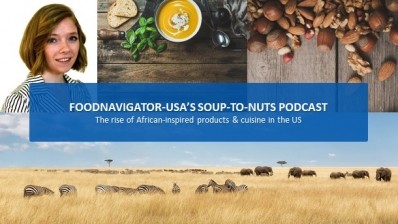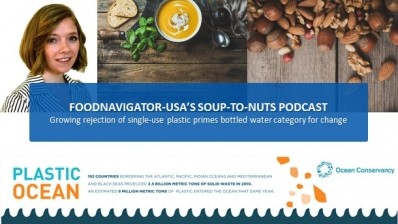Soup-To-Nuts Podcast: Increased transparency translates to increased consumer loyalty, sales

In FMI’s recently published report, The Transparency Imperative, three-quarters of shoppers surveyed said they are more likely to switch to a brand that provides more in-depth product information beyond what is on the packaging and required by law. This is nearly double the 39% who said the same thing just two years earlier.
But what exactly are consumers looking for from brands, and how does that changed based on their age and life-stage? How do diet trends and increased health and wellness awareness factor into consumer evaluations of transparency? What is the influence of ecommerce on transparency demands? And why exactly should industry care and go to the extra trouble to meet consumer demands around increased transparency?
To find out, we talk with FMI Vice President of Industry Relations, Doug Baker, who in this episode of FoodNavigator-USA’s Soup-To-Nuts podcast also shares advice for meeting consumers’ transparency demands and keeping track of their changing whims.
Consumers’ frame of mind
According to FMI’s report more than 90% of consumers say it is important for brands and manufacturers to share details about what is in food and how it is made. At the same time, two-thirds of shoppers say they are confused by product labels and ingredient lists. This disjoint is creating an opportunity for brands to win over consumers by improving their transparency.
“The confusion [consumers have comes from] trying to educate themselves. So, they are looking for that information wherever they can find it, and unfortunately, there is information coming from everywhere,” Baker said.
He advocates the best case scenario for brand, retailers and consumer is if industry takes control of the narrative and provides information as a “single source of the truth that is hopefully going to help start eliminating that confusion.”
Companies that rise to this challenge and help clarify for consumers what is in products, how they are made and what benefits they offer will be reward. According to FMI’s research, 78% of shoppers say they are more likely to buy food products that provide more in-depth product information and 80% agree they are more likely to be loyal to a brand that provides more in-depth information beyond the physical label.
In addition, the research found, more than half of shoppers said they would pay more for a product that offers more in-depth product information.
This, of course, cuts both ways with 69% of shoppers saying they would be less likely to buy a food product if it was not transparent about its ingredients, for example, according to the report.
A shifting definition of transparency
But what exactly do consumers mean when they say they want companies to be ‘transparent’? And what information is most important to them?
“Although there is definition for transparency, from a consumer mindset it is very personal. So, if you put 10 people in front of you and asked them what is their definition of transparency, you could get eight different responses,” Baker said.
He explained that how consumers define transparency likely depends on their generation and life-stage.
“If you are a single individual, you might be very focused on social awareness. As you have a family and have children that still might be important to you, but now nutrition becomes more important to you because you are now raising a young child in your home and you want to make sure you provide for it the most nutritious food,” Baker explained.
“As you move into your Boomer and Gen X years, it is more about yourself now and how can you have a happy and healthy life and live longer,” he added.
Regardless of generation and life stage, most consumers agree that the most important element of being transparent is providing a complete list of ingredients. Coming in a close second, according to the report, is explaining those ingredients in plain English.
The report also found that about a third of consumers want information about how products are produced and ingredients are sourced, and if there are allergens. Slightly fewer at 29% wanted to see certifications and claims. In particular, 26% want to see value-based information such as animal welfare and 20% want to know about sustainability practices.
How health perceptions impact transparency demands
Rising awareness about health and wellness and the role that diet plays in overall wellbeing also is influencing consumer demand for and perceptions of transparency.
“A lot of times this transparency desire for certain generations comes with a life event” such as learning you have hypertension and need to reduce sodium intake or discovering a family member has an allergy, Baker said.
According to FMI’s report, almost half of American households have someone who is dieting or trying to manage their health through diet, and a third of homes have someone who is managing allergies, intolerances or sensitivities.
These shoppers also are more likely to spend more on groceries – averaging about $136. And as we already mentioned, consumers are more willing to direct this money towards brands that help them manage their needs by providing more information.
Omnichannel’s influence
According to FMI, these consumers also are much more likely to shop online, in addition to in brick and mortar stores – creating multiple touchpoints for brands to provide additional information.
Baker also notes that while online grocery shopping is still relatively small, it is gaining traction quickly among all consumers, and thus should be considered when brands and retailers develop their information-sharing game plans.
Take action
With consumers shopping across multiple channels it becomes more important that brands and retailers provide the information they want across multiple platforms so that they can access it anytime, anywhere.
“For a consumer, the easiest place for them to focus is on pack or at shelf … but then there is also this opportunity from a secondary way of communicating by going beyond the label,” Baker said.
A good example of this is the industry’s voluntary Smart Label initiative that allows consumers to learn more about a product by scanning a QR code or the products UPC code and going to a dedicated webpage created by the brand, said Baker.
He acknowledged that getting online in retail stores can be a challenge but that industry is pushing to provide WiFi in more stores so that there is easier access at shelf. But, he also noted, many consumers will research before and after shopping when they have access to the Internet.
Baker acknowledges that Smart Label is not the only option for sharing in-demand information with consumers, but he says other options may have drawbacks, such as limiting characters or what data can be displayed.
Ultimately, Baker says, “no matter where you are at on your journey with transparency, you should continue to listen to your consumer, continue to take advantage of resources like The Transparency Imperative research to learn more about consumers in general. And then, engage in industry activities” that will “benefit your relationships with your consumers.”



















